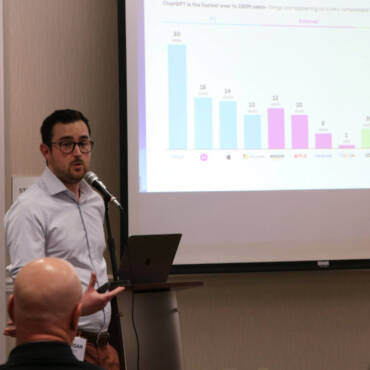Gary McCreadie is an HVAC tech, the creator of hvacknowitall.com and the HVAC Know It All Podcast
If you really want to understand this article in detail, I suggest reading the “Refrigeration Cycle Explained” before moving on. If you already have a firm grasp on the refrigeration cycle, stay and hang out for a bit.
An evaporator, as it pertains to the refrigeration cycle is the portion of the system where heat is absorbed from a medium. That medium could be air, water, glycol or brine solution. For this article we’ll focus on air. As air passes over an evaporator coil, the evaporator absorbs heat, the entering air for example could be 75⁰F and the air leaving could be 55⁰F, that gives us a difference of 20⁰F or a delta t (temperature difference of the same medium) of 20⁰F. This is just a generic example to show that as air passes over an evaporator coil, it removes heat from the air.
Now that we understand the function of an evaporator, we need to understand that it’s normal for an evaporator to freeze in some applications, like low temperature refrigeration, where evaporator temperatures fall below freezing, 0⁰C or 32⁰F. In these scenarios, the system is set up with a defrost cycle. The defrost cycle is a time or temperature initiated process that will shut down the refrigeration cycle, it will utilize electric heaters or diverted hot gas to melt and remove the ice from the coil. In this article though, we will focus on air conditioning applications where a frozen evaporator is indeed problematic.
You need to remember something very important, no matter the cause of the freeze up, the isolated conditions in the evaporator will always remain constant, low pressure and low temperature. So, regardless of what’s happening upstream, a frozen coil will always look the same when looking at the evaporator conditions. These conditions can range however, we could see a system on the border line of low pressure/temperature to well below freezing, but the end result will still be a frozen evaporator.
Check out this episode of the HVAC Know It All Podcast discussing “Why Evaporators Freeze”
The Reasons
Let’s cover a few well known or common reasons an evaporator can freeze.
Low Charge
Simply put, the refrigerant charge is insufficient to bring the evaporator up to it’s normal running pressure. Let’s use a 40 degree F. saturated suction temperature or SST, this seems to be a common number. It doesn’t matter the type of refrigerant, if you are trying to achieve a 40⁰F SST, then you’re trying to achieve a 40⁰F SST. If we have a leak in a system or don’t add enough refrigerant on start up or after a repair, we can freeze up, if our evaporator SST begins to drop below 32⁰F. Yes, we may have superheat, this added heat can bring the coil back up above freezing temporarily, but with a low charge, our system is running inefficiently and can create longer run times. These longer run times, coupled with a drop in return air temperature is a perfect storm for an evaporator to begin to freeze. If all things are working as they should, a properly charged system will prevent freezing.
In this Instagram post, I give some feedback on a low charge issue where AC Smart Seal was used on a Liebert unit which had an evaporator micro leak.
Lack of Air Flow
As air flow is reduced, due to a dirty filter, plugged secondary heat exchanger (found on high efficiency furnaces), duct work issues or a failing fan motor for example, it can lower the evaporator pressure/temperature. This happens because there is not enough available heat to be absorbed from the slowly moving air. In layman’s terms, the more heat there is to be absorbed the higher the evaporator pressure/temperature. The less heat there is to be absorbed the lower the evaporator pressure/temperature. This is why it’s important to ensure duct work is designed properly and balanced. It’s also equally as important to ensure potential obstructions, like air filters and evaporator coils stay clean.
The SUPCO Freeze Protection Control can be mounted on a suction line up to 7/8″ to provide freeze protection.

Liquid Line Restriction
A liquid line restriction is usually found within a liquid line filter drier or system metering device. For example, if a filter drier starts collecting system debris and flow is reduced, a pressure drop is usually the culprit. The pressure drop will cause a lower outlet pressure at the filter drier, if the pressure is low enough the metering device will not receive a full column of liquid. This in turn, will cause a lower than normal evaporator pressure/temperature. If that pressure/temperature relationship falls below 32⁰F then freezing may occur.
Tip: If a liquid line filter drier has 2⁰F or more measured across it, we can presume it’s partially restricted and needs to be replaced.
If the metering device, which could be a capillary tube, fixed orifice, thermal expansion valve or these days, an electronic expansion valve becomes blocked or restricted, it will most definitely create an excessive pressure drop. Keep in mind that a pressure drop though a metering device is perfectly normal, but a pressure drop outside of design conditions, that adds more restriction than needed will indeed cause lower evaporator pressure/temperatures than wanted. Again, if that relationship falls beyond the freezing mark, frost/ice will start to form on the coil.
In this short video, I cover a quick run down of a thermal expansion valve. Subscribe to the channel, if you enjoy the content.
In Conclusion
Remember, all of the conditions we covered above will contribute to the same conclusion, low evaporator pressure/temperature relationships, if they become too low, freezing can occur. It’s up to thr service technician to determine the root cause of the freeze up and correct it.
Tip: In order to troubleshoot the issue, we must fully thaw the evaporator coil first before attempting to diagnose.
Gary McCreadie
Subscribe to the HVAC Know It All app
Follow HVAC Know It All on Instagram, Facebook, YouTube and LinkedIn and LISTEN to the HVAC Know It All Podcast
Save 8% on purchases at TruTech Tools with code knowitall (excluding Fluke and Flir products)












Whether you require installation, repair, or maintenance, our technicians will assist you with top-quality service at any time of the day or night. Take comfort in knowing your indoor air quality is the best it can be with MOE heating & cooling services Ontario's solution for heating, air conditioning, and ventilation that’s cooler than the rest.
Contact us to schedule a visit. Our qualified team of technicians, are always ready to help you and guide you for heating and cooling issues. Weather you want to replace an old furnace or install a brand new air conditioner, we are here to help you. Our main office is at Kitchener but we can service most of Ontario's cities
Source link







Add Comment